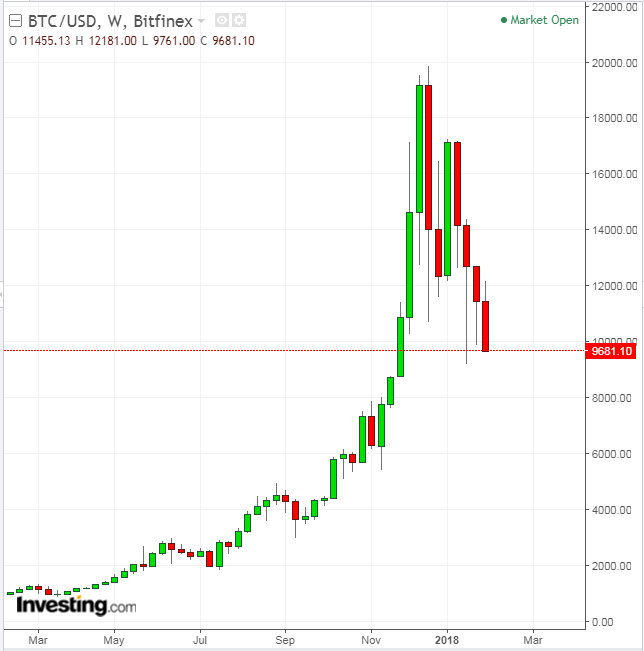Cryptocurrency prices are dropping. Bitcoin has been struggling to stay above $10K even as, over the past week, other popular currencies, including Bitcoin Cash, Ripple, Cardano and Litecoin, have all declined in value. Is some sort of fatigue seeping into crypto investor interest?

Many believe we are now seeing a market shakeout, an inflection point where investors who are in it just to be highly speculative—and get rich quick—without any particular knowledge of the merits of the asset class are turning elsewhere. These investors may have seen the crypto boom as an opportunity to come in fast, take big profits and move on—without ever really understanding the value of any of the alternative currencies or the blockchain technology powering them.
This may be part of the reason alt-currency prices are sinking. On the other hand, those still investing in cryptocurrencies are likely the true believers...knowledgeable, smart investors whose participation will help the market arrive at more accurate, more appropriate pricing, volatility and growth.
Noobs versus Vets
Jeffrey Van de Leemput the co-founder of Cryptocampus, who also mentors crypto investors, concurs:
"I believe that what we are seeing now is a market shakeout after the parabolic uptrend has been broken. These are corrections that last over a month and can even take over six months to complete. Keep in mind that a year ago bitcoin was sitting at about one thousand dollars. So even though this "crash" might appear large, it really is not. It is just a natural reaction after such a great run up.”
FUD factor
Marc Kenigsberg, a Bitcoin and blockchain advocate, explains that there is a lot of “FUD” ( fear, uncertainty and doubt) in the market at the moment. As well there are many potentially correlated events that could be driving this dip but no clear, obvious single cause:
“In fact right now the market should be bullish on bitcoin considering the reduction in fees, lightning network growth and the Robinhood apps's users waiting to get in. The one thing that we know for certain is that as HODLers hold and speculators sell the percentage of HODLers increases. This bodes extremely well for upward price pressure when the imminent correction to a higher fair bitcoin price occurs.”
The wrong reasons to be in crypto
It's no secret that during 2017, Bitcoin, as well as sister cryptocurrencies, garnered significant media attention. Edd Carlton, head of OTC Trading BlockEx, a digital asset exchange platform, points out that some investors entered the crypto markets for all the wrong reasons at the back end of 2017: primarily driven by FOMO (fear of missing out) in tandem with substantial mainstream media hype around what was arguably an exceptional Q4 for the asset class. He says:
“I think there are two forces at play in the market at present. One is arguably the weak hands leaving the market - i.e the individuals that entered looking for the quick returns and a continuation of Q4 2017 have been sorely disappointed - many cutting their losses and selling on dips rather than adopting a long-term investment horizon and HODL-ing [sic].
The second factor at work, the ‘stronger hands’ and more experienced investors are looking to diversify their crypto portfolios, spreading risk across a number of crypto-currencies,[and] in doing so diluting the previous ‘status quo’ of a market dominated by one or two market cap majority holders. BTC is no longer holding 60-70% of market cap dominance. We view the current state of play as positive and sign of a more mature market where numerous opportunities to the upside will present themselves in due course.”
Cryptocurrency fatigue?
Are some crypto investors also suffering from fatigue? Arturas Asakavicius, the COO and co-founder of WePower, a platform for green energy trading via the blockchain, clarifies the nature of the current sentiment:
“I wouldn't call it fatigue, but the crypto market is indeed evolving and changing.
Historically, it was heavily dominated by Bitcoin but this year a big part of its share has shifted to the alternative currencies such Ethereum or Ripple as well as to the large range of tail currencies. It is hard to pinpoint the exact factors of this change but I have indeed seen many more institutional investors showing interest and making their first steps in this market.
Actually, a large part of our token sales round was covered by funds and investors with a more traditional background but very strong interest in the offering of the blockchain technology. If a similar trend is true across the industry, it might indeed indicate that we are moving towards a more professional and less volatile market.”
If the cryptocurrency market is indeed seeing a shift in the tone and nature of alt-currency investors, a saner, less wild environment could be good news for all who choose to enter in future, or decide to remain.
